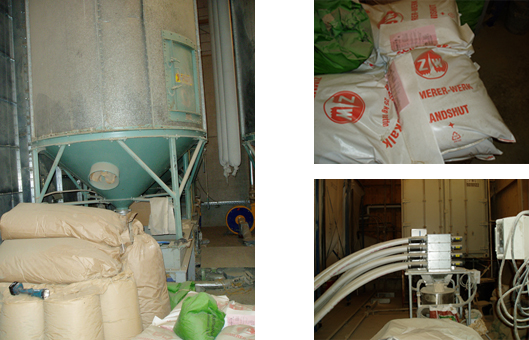Herrmannsdorfer Farms
September 2008 – H. Soper
On September 14, 2008 I toured the Herrmannsdorfer Farms in Bavaria near Munich, Germany. Tommi Berron was my guide. If Herrmanndorfer Farms were a bookend, it would be at the opposite end of the bookshelf from Soper Farms as regards farming practices and outcome. SFI follows a “monoculture” model (monoculture is the practice of producing or growing one single crop over a wide area). I don’t know the term that best describes Herrmanndorfer Farms except to describe it as a self-sustaining farm that delivers its agricultural products from the ground directly to the consumer. Adding value at every step, it is vertically integrated in most everything it does.
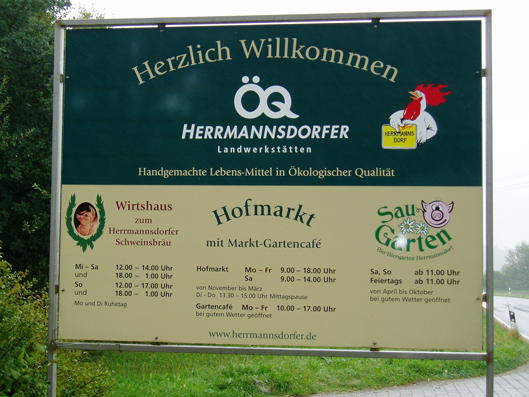 Founder – Herrmannsdorfer Farms (HF) are the result of a 20+ years of effort by Karl Ludwig Schweisfurth and his family. Karl was a butcher with very large slaughterhouse operations across Germany. At the encouragement of his family he sold his slaughterhouse holdings years back and changed his focus to move from industrial food production to sustainable, organic production. Today he remains the chairman and goodwill ambassador of HF while his son, Karl Jr. runs all the day-to-day activities and enterprises of the farms.
Founder – Herrmannsdorfer Farms (HF) are the result of a 20+ years of effort by Karl Ludwig Schweisfurth and his family. Karl was a butcher with very large slaughterhouse operations across Germany. At the encouragement of his family he sold his slaughterhouse holdings years back and changed his focus to move from industrial food production to sustainable, organic production. Today he remains the chairman and goodwill ambassador of HF while his son, Karl Jr. runs all the day-to-day activities and enterprises of the farms.
HF Credo – The over arching principles that guide all HF enterprises is the belief that farming can be done in a sustainable way whereby nothing is wasted, crops are grown free of pesticides and chemicals and animals raised for slaughter should live a healthy, longer and happy life. The result is healthy premium quality foods delivered with the lowest possible carbon footprint.
Overview – HF is a profitable venture that occupies approximately 300 acres of land a short distance from the major cosmopolitan area of Munich. Proximity to a population large enough and prosperous enough to pay for premium organic products is critical to their success. On these 300 acres HF employs over 100 people. From these 300 acres HF has vertically integrated nearly every aspect of what this land can produce. From their organic fields, direct to the mouths of their consumers, HF produces pork, fresh vegetables, baked goods, beer, and liquors. With few exceptions all their products come directly from the productivity of their own land.
Branding – As unique as this farm and its products are, it requires HF to receive a premium price for their products while captureing all the profit margin available at every level of production and selling to the end user. To succeed, HF has built a strong brand name. Branding through multiple levels of marketing and retail is a critical part of their success in both creating a loyal customer following and in competing with other organic farms in Germany.
A Destination – HF is both a working farm and a destination for tourists, diners and shoppers. There is seldom a month that passes without an event from harvest festivals to music concerts to art shows and craft markets on the farm. Visitors are generally free to roam the grounds to see the operation and ask questions. On the farm site there is a full, upscale restaurant that features HF meat, produce and drinks. HF also sponsors programs that bring children to the farm for overnight stays living in tents and yurts to learn about the environment, ecology and organic sustainable living.
Farm Production – To begin, Karl and his key managers farm with an acute understanding of what is required to sustain the quality of their land. HF ground is about average. On a scale of 1 to 10 the quality of the soil is about 5. Over the years HF has developed crop rotation formulas and farming practices that yield the highest quality results while maintaining or increasing the yield capacity of their ground. These formulas are not static however and constant experimentation occurs to improve productivity at the lowest cost possible.
Welcome to Herrmannsdorfer Farms
 Crops – Without going into details of their crops and rotation procedures, it is important appreciate the variety of crops grown. Every crop is grown to integrate into the total organic production plan.
Crops – Without going into details of their crops and rotation procedures, it is important appreciate the variety of crops grown. Every crop is grown to integrate into the total organic production plan.
Fresh Vegetables and Flowers – A wide variety of garden vegetables are grown and sold directly to the public through HF shops and restaurant.
 These fresh vegetables occupy only a small area of the farms. The gardens operate year round either outside during the growing season or in a hot house for off-season.
These fresh vegetables occupy only a small area of the farms. The gardens operate year round either outside during the growing season or in a hot house for off-season.
 The flower garden is open to the public to come and pick. The vegetables are sold in the shop directly across the lane. The proximity of their garden produce to their store is important because it connects the customers with the freshness of the products and shipping cost are limited to a wheel borrow and about 50 yards distance.
The flower garden is open to the public to come and pick. The vegetables are sold in the shop directly across the lane. The proximity of their garden produce to their store is important because it connects the customers with the freshness of the products and shipping cost are limited to a wheel borrow and about 50 yards distance.
The Store – This store is on-site and sells only organic products. HF also has other similar retail outlets owned by HF in Munich only a short distance away. Proximity to market is important.
 This happy shopper is amazed with the selection of seasonal vegetables that were picked just hours ago. This is the first thing you see when entering the store.
This happy shopper is amazed with the selection of seasonal vegetables that were picked just hours ago. This is the first thing you see when entering the store.
 This case includes all the bakery goods that are produced on the farm in their own ovens using grains raised on HF land. The Cheese counter includes cheeses made on site. HF doesn’t raise their own dairy cattle or goats so the milk is bought from nearby organic dairy farmers.
This case includes all the bakery goods that are produced on the farm in their own ovens using grains raised on HF land. The Cheese counter includes cheeses made on site. HF doesn’t raise their own dairy cattle or goats so the milk is bought from nearby organic dairy farmers.
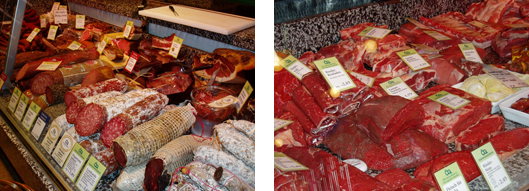 The meat and sausage counter is a very busy place with all the meats having never been frozen. If you have an appreciation for sausages, this is another specialty where the contents are put together when the meet is “warm”, freshly slaughtered.
The meat and sausage counter is a very busy place with all the meats having never been frozen. If you have an appreciation for sausages, this is another specialty where the contents are put together when the meet is “warm”, freshly slaughtered.
To offer a wider variety of organic products, HF stores sell a complement of products made by other organic manufacturers including condiments, jams, fresh sauces … just about everything you would need to create great organic meals.
 No meal is complete without some libation. Here are two of the numerous Schweinbrau (Pig) Beer HF produces in its own brewery.
No meal is complete without some libation. Here are two of the numerous Schweinbrau (Pig) Beer HF produces in its own brewery.
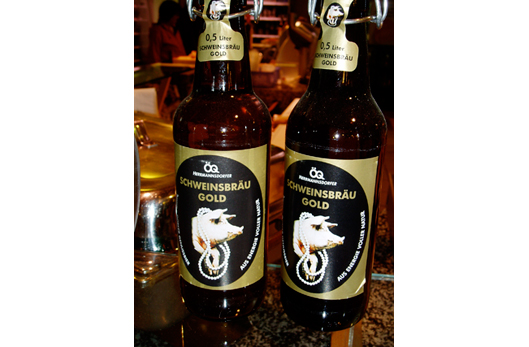 At the checkout counter there are also mugs, glasses and cookbooks to help fill your basket. And, as mentioned before, nothing is wasted and all day-old bread and whey by-products from the cheese production are fed to some very eager eaters in the in the pig pens.
At the checkout counter there are also mugs, glasses and cookbooks to help fill your basket. And, as mentioned before, nothing is wasted and all day-old bread and whey by-products from the cheese production are fed to some very eager eaters in the in the pig pens.
Hogs – In addition to harvesting solar energy from SV panels, HF also produces biogas from livestock effluents. Again, repeating the motto, “waste nothing”.
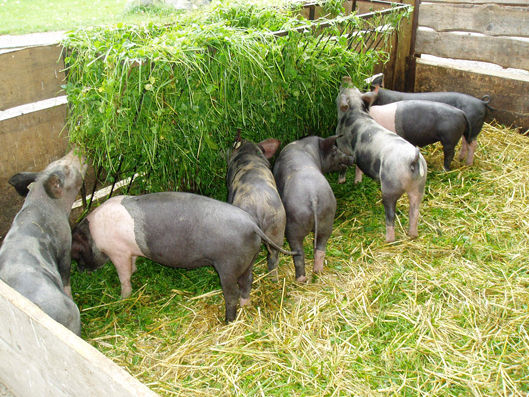 These pigs are feasting on fresh clover cut that day from nearby fields. The clover is a special variety that produces nutrients that are both good for the pigs and the soil. There was a serious feeding frenzy over this fresh clover.
These pigs are feasting on fresh clover cut that day from nearby fields. The clover is a special variety that produces nutrients that are both good for the pigs and the soil. There was a serious feeding frenzy over this fresh clover.
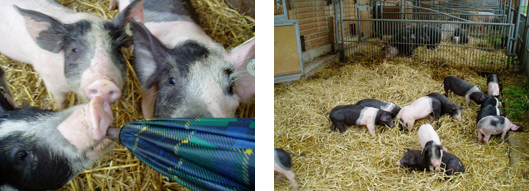 Unlike pigs in many commercial feeding operations I’ve visited in the US, these pigs run to meet you when you approach the pen just in case you want to give them a good scratch. Fresh straw (grown on the farm) is put down daily and all the pens are designed to provide plenty of space so the pigs can move about without the stress of crowded conditions. These stock are a special breed of spotted pig that HF has determined make the best product. I’ve never seen such happy pigs!
Unlike pigs in many commercial feeding operations I’ve visited in the US, these pigs run to meet you when you approach the pen just in case you want to give them a good scratch. Fresh straw (grown on the farm) is put down daily and all the pens are designed to provide plenty of space so the pigs can move about without the stress of crowded conditions. These stock are a special breed of spotted pig that HF has determined make the best product. I’ve never seen such happy pigs!
 Notice the solar panels on the roof of each barn. Again, HF harvests everything and not even the sunlight is wasted. These panels are one part of the energy generation that goes on to supply the farm with power.
Notice the solar panels on the roof of each barn. Again, HF harvests everything and not even the sunlight is wasted. These panels are one part of the energy generation that goes on to supply the farm with power.
 At a certain weight the pigs are put out to pasture where they, in large part, root and graze for themselves. This is a key point to HF farming practices … animals are required on their farm to complete a full cycle environment as their feeding practices and effluents contribute to sustainable farming. In this picture you’ll notice chickens. This is a recent experiment whereby the chickens eat the microbes left behind by the pig’s effluents. The pigs also act as a “protector” of the chickens from local foxes. The two buildings in the background house both the pigs living on the bottom and the chickens roosting above enjoying the warmth produced from the pigs below.
At a certain weight the pigs are put out to pasture where they, in large part, root and graze for themselves. This is a key point to HF farming practices … animals are required on their farm to complete a full cycle environment as their feeding practices and effluents contribute to sustainable farming. In this picture you’ll notice chickens. This is a recent experiment whereby the chickens eat the microbes left behind by the pig’s effluents. The pigs also act as a “protector” of the chickens from local foxes. The two buildings in the background house both the pigs living on the bottom and the chickens roosting above enjoying the warmth produced from the pigs below.
Bio Energy Production – The hog operations include a variety of pens used to house and feed the livestock. Depending on the weight, a hog is put in a pen where appropriate feeds are supplied.
 This simple device installed on the floor of the pens is pulled by a cable. It opens up to pull the old straw and effluents from the floor. This is the first stage in a complete bioenergy production system used to produce methane gas to power the farm.
This simple device installed on the floor of the pens is pulled by a cable. It opens up to pull the old straw and effluents from the floor. This is the first stage in a complete bioenergy production system used to produce methane gas to power the farm.
 The animal waste is first gathered in this pit that conveys it …
The animal waste is first gathered in this pit that conveys it …
 … to a mixer that reduces the matter to smaller particles from which methane is produced as the material decomposes.
… to a mixer that reduces the matter to smaller particles from which methane is produced as the material decomposes.
 The last step is this pond where the effluents are finally treated by nature to allow the water to be recycled. The gas is burned in a piston engine to run a generator that powers the facility. Even the heat put off in the process is recycled to heat other buildings.
The last step is this pond where the effluents are finally treated by nature to allow the water to be recycled. The gas is burned in a piston engine to run a generator that powers the facility. Even the heat put off in the process is recycled to heat other buildings.
Milling Feed – All the grains used to feed the livestock are grown and milled on site.
The only additives are vitamin supplements that are added to the feed.
 There are various mixes of grain and vitamins that are programmed by computer, mixed and delivered to the pens via this pneumatic system. I mentioned that HF is constantly reviewing its practices to achieve greater results within their organic, sustainable model. This pneumatic system is under review and modification so it may be used to deliver fresh beets that BF grows and feeds to the livestock.
There are various mixes of grain and vitamins that are programmed by computer, mixed and delivered to the pens via this pneumatic system. I mentioned that HF is constantly reviewing its practices to achieve greater results within their organic, sustainable model. This pneumatic system is under review and modification so it may be used to deliver fresh beets that BF grows and feeds to the livestock.
Slaughter – I didn’t take pictures of the slaughterhouse as access was limited for hygiene purposes, but I observed how HF applies its philosophy that the humane treatment of their livestock results in a much higher quality product. When the pigs move from pen to field, they do so under their own power, happily walking and running as they are guided from one location to the other.
In this last stage, the pigs walk themselves under no stress to large, uncrowded holding pens the day before being rendered. Then, one by one, they pig is taken in for slaughter. It is HF’s belief that if the animal is fearful and stressed, their bodies put out adrenaline that affects the taste and quality of the meat. Therefore, the slaughter environment is carefully designed and laid out to be stress-free.
Once slaughtered, the meat is all prepared at that moment while warm and sent directly to the stores and restaurant. For some pork products, HF smokes the meat in their smoke house.

Historical Footnote: – The smokehouse was built in the traditional 19th century Bavarian style using wood and mud/straw as mortar. What a beautiful structure and another example of how HF makes the farm a destination of interest, further building its brand.
Tourist Area – The center of the farm is where the public spends much of its time. Surrounding a large courtyard are many buildings.
 Above left is a playground area for children. Above right is a statue of a bull and behind is a dormitory for employees and interns.
Above left is a playground area for children. Above right is a statue of a bull and behind is a dormitory for employees and interns.
Art – To digress a moment, HF has a resident artist that lives on site and you see artwork everywhere. Let me stress again that this is all part of building a destination of interest and creating a brand. Here are some examples.
 Above left is a contemporary version of the traditional Bavarian May Pole. Middle is a fountain ringed by posts on top of which is a message spelled out letter by letter. Right are statues with farm themes.
Above left is a contemporary version of the traditional Bavarian May Pole. Middle is a fountain ringed by posts on top of which is a message spelled out letter by letter. Right are statues with farm themes.
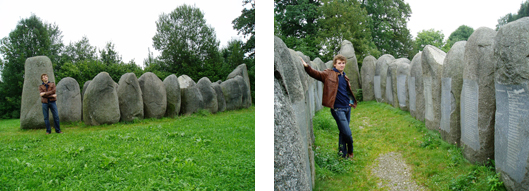 Art is found even out in the middle of the fields. This Stone-henge styled piece commemorates over 5,000 species in the region that have become extinct.
Art is found even out in the middle of the fields. This Stone-henge styled piece commemorates over 5,000 species in the region that have become extinct.
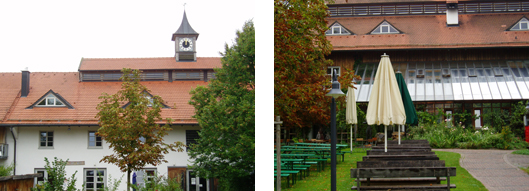 These buildings ring the center courtyard with meeting rooms and workshops above left and the main building on the upper right. This main building was formerly a barn but converted to hold the restaurant, bakery, cheese production on the first and second floors, offices on the third and the butchery in the basement far left (out of sight and mind).
These buildings ring the center courtyard with meeting rooms and workshops above left and the main building on the upper right. This main building was formerly a barn but converted to hold the restaurant, bakery, cheese production on the first and second floors, offices on the third and the butchery in the basement far left (out of sight and mind).
 Above is the milling room where they mill the grains to be baked and above right is the bakery.
Above is the milling room where they mill the grains to be baked and above right is the bakery.
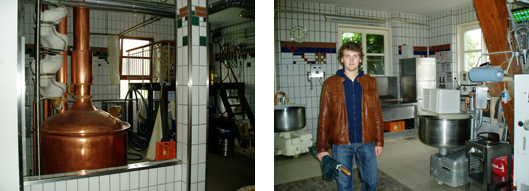 Above left is the brewery and above right is Tommi standing in the kitchen.
Above left is the brewery and above right is Tommi standing in the kitchen.
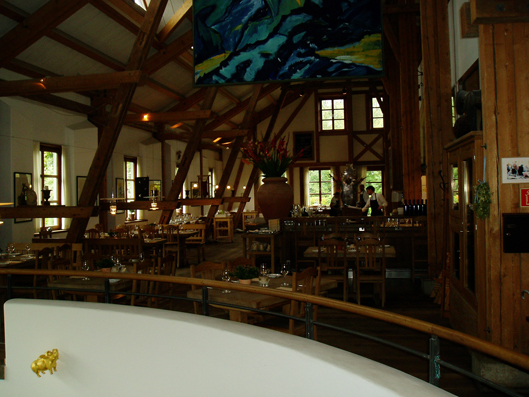 At the top of a central circular stairway is the restaurant that serves affordable but highly crafted food, most of which comes from the farm.
At the top of a central circular stairway is the restaurant that serves affordable but highly crafted food, most of which comes from the farm.
Business Model – This is an appropriate time to mention HF’s hybrid business model. In the case of the farms, hog operations, shop, and brewery HF owns and operates them all. Where specialized expertise is required such as the restaurant and cheesery, local entrepreneurs are contracted.
Education – Running throughout the HF business model is an effort to educate the public on the themes of organic foods, health, the environment and how it all is interconnected. Tommi Berron experienced this as a 2-year intern working on the farms learning the details and practices of organic farming. HF also runs summer camps for children teaching how to create and live in a healthy and sustainable world..
 The camping facilities are beautiful and create an environment of fun and learning. Above is the teepee where campers live.
The camping facilities are beautiful and create an environment of fun and learning. Above is the teepee where campers live.
 Opposite the teepee is a yurt that also houses campers.
Opposite the teepee is a yurt that also houses campers.
 And where ever possible, sustainable practices are used. Above left are the showers for the campers. Upper right shows the hot water source … a compost pit with coiled water pipes that draw the natural heat from the compost process. You may not be aware that compost piles can get hot enough to catch fire naturally. The water for the showers is very warm.
And where ever possible, sustainable practices are used. Above left are the showers for the campers. Upper right shows the hot water source … a compost pit with coiled water pipes that draw the natural heat from the compost process. You may not be aware that compost piles can get hot enough to catch fire naturally. The water for the showers is very warm.
Old Farming Practices – As the tour of HF progressed it became clear that the practices they used (with a little help from modern technology) were every day practice on farms at the turn of the 20th century. In fact, some of the tools used are found in antique implement stores. The machinery needed is small by comparison to the equipment used for SFI farming and often bought used, understanding it is better to reuse and recycle when ever possible. As a reminder, HF sits on only 300 acres (small by US farming practices), is profitable, organic, sustainable and provides jobs for over 100 employees.
Soper Farms Challenge – In many regards, Herrmanndorfer Farms are a trip back to the future, existing at the opposite end of Iowa farming practices. This report is not intended as a recommendation for SFI but as an example as to what farming is like at the other end of the spectrum. In our current world of monoculture farming, SFI is extremely well managed with care taken to be the best stewards possible of the environment because it makes good business and environmental sense.
Beyond this report, SFI volunteers will be looking at many of the practices we might choose to follow that lie between these two pole stars of farming. Our future as a family group with the resources to stay closely connected is guaranteed. Beyond this, the opportunity we have as a group is to create a legacy if we choose, that will further define our stewardship on this one and only Earth. Herrmanndorfer Farms may be a model.

